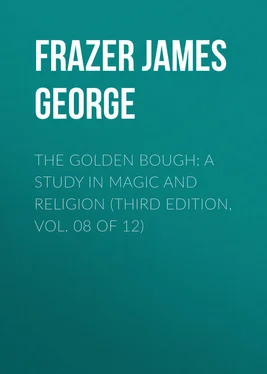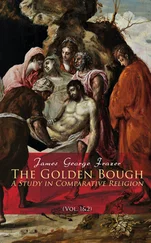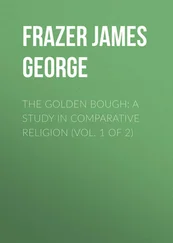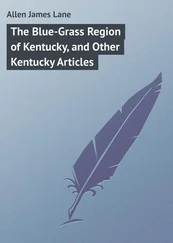James Frazer - The Golden Bough - A Study in Magic and Religion (Third Edition, Vol. 08 of 12)
Здесь есть возможность читать онлайн «James Frazer - The Golden Bough - A Study in Magic and Religion (Third Edition, Vol. 08 of 12)» — ознакомительный отрывок электронной книги совершенно бесплатно, а после прочтения отрывка купить полную версию. В некоторых случаях можно слушать аудио, скачать через торрент в формате fb2 и присутствует краткое содержание. Жанр: foreign_religion, foreign_antique, foreign_prose, на английском языке. Описание произведения, (предисловие) а так же отзывы посетителей доступны на портале библиотеки ЛибКат.
- Название:The Golden Bough: A Study in Magic and Religion (Third Edition, Vol. 08 of 12)
- Автор:
- Жанр:
- Год:неизвестен
- ISBN:нет данных
- Рейтинг книги:4 / 5. Голосов: 1
-
Избранное:Добавить в избранное
- Отзывы:
-
Ваша оценка:
- 80
- 1
- 2
- 3
- 4
- 5
The Golden Bough: A Study in Magic and Religion (Third Edition, Vol. 08 of 12): краткое содержание, описание и аннотация
Предлагаем к чтению аннотацию, описание, краткое содержание или предисловие (зависит от того, что написал сам автор книги «The Golden Bough: A Study in Magic and Religion (Third Edition, Vol. 08 of 12)»). Если вы не нашли необходимую информацию о книге — напишите в комментариях, мы постараемся отыскать её.
The Golden Bough: A Study in Magic and Religion (Third Edition, Vol. 08 of 12) — читать онлайн ознакомительный отрывок
Ниже представлен текст книги, разбитый по страницам. Система сохранения места последней прочитанной страницы, позволяет с удобством читать онлайн бесплатно книгу «The Golden Bough: A Study in Magic and Religion (Third Edition, Vol. 08 of 12)», без необходимости каждый раз заново искать на чём Вы остановились. Поставьте закладку, и сможете в любой момент перейти на страницу, на которой закончили чтение.
Интервал:
Закладка:
Still more clearly, perhaps, does the identification of the corn-spirit with an ox come out in the sacrificial ritual which the Greeks of Magnesia on the Maeander observed in honour of Zeus Sosipolis, a god whose title of Sosipolis (“Saviour of the City”) marks him as the equivalent of Zeus Polieus (“Zeus of the City”). The details of the ritual are happily preserved in an inscription, which records a decree of the council and of the people for the regulation of the whole proceedings. Every year at a festival in the month of Heraeon the magistrates bought the finest bull that could be had for money, and at the new moon of the month of Cronion, at the time when the sowing was about to begin, they and the priests dedicated the animal to Zeus Sosipolis, while solemn prayers were offered by the voice of a sacred herald for the welfare of the city, of the land, and of the people, for peace and wealth, for the corn-crops and all other fruits, and for the cattle. Thereafter the sacred animal was kept throughout the winter, its keep being undertaken by a contractor, who was bound by law to drive the bull to the market and there collect contributions for its [pg 008] maintenance from all the hucksters and in particular from the corn-chandlers; and a prospect was held out to such as contributed that it would go well with them. Finally, after having been thus maintained at the public cost for some months, the bull was led forth with great pomp and sacrificed in the market-place on the twelfth day of the month Artemision, which is believed to have been equivalent to the Attic month of Thargelion and to the English month of May, the season when the corn is reaped in the Greek lowlands. In the procession which attended the animal to the place of sacrifice the senators, the priests, the magistrates, the young people, and the victors in the games all bore a part, and at the head of the procession were borne the images of the Twelve Gods attired in festal array, while a fluteplayer, a piper, and a harper discoursed solemn music. 28 28 Dittenberger, Sylloge Inscriptionum Graecarum 2 (Leipsic, 1898-1901), vol. ii. pp. 246-248, No. 553. As to the identification of the Magnesian month Artemision with the Attic month Thargelion (May), see Dittenberger, op. cit. ii. p. 242, No. 552 note 4. It is interesting to observe that at Magnesia the sowing took place in Cronion, the month of Cronus, a god whom the ancients regularly identified with Saturn, the Italian god of sowing. In Samos, Perinthus, and Patmos, however, the month Cronion seems to have been equivalent to the Attic Scirophorion, a month corresponding to June or July, which could never have been a season of sowing in the hot rainless summers of Greece. See E. Bischoff, “De fastis Graecarum antiquioribus,” in Leipziger Studien für classische Philologie , vii. (1884) p. 400; Dittenberger, Sylloge Inscriptionum Graecarum , 2 No. 645 note 14, vol. ii. p. 449.
Now in the bull, which was thus dedicated at the time of sowing and kept at the cost of the pious, and especially of corn-chandlers, to be finally sacrificed at harvest, it is reasonable to see an embodiment of the corn-spirit. Regarded as such the animal was consecrated when the seed was committed to the earth; it was fed and kept all the time the corn was growing in order that by its beneficent energies it might foster that growth; and at last, to complete the parallel, when the corn was reaped the animal was slain, the cutting of the stalks being regarded as the death of the corn-spirit. 29 29 In thus interpreting the sacrifice of the bull at Magnesia I follow the excellent exposition of Professor M. P. Nilsson, Griechische Feste (Leipsic, 1906), pp. 23-27.
Similarly we have seen that in the harvest-fields and on the threshing-floors of modern Europe the corn-spirit is often conceived in the form of a bull, an ox, or a calf, which is supposed to be killed at reaping or threshing; and, [pg 009] further, we saw that the conception is sometimes carried out in practice by slaughtering a real ox or a real calf on the harvest-field. Thus the parallelism between the ancient Greek and the modern European idea of the corn-spirit embodied in the form of a bull appears to be very close.
On the interpretation which I have adopted of the sacrifices offered to Zeus Polieus and Zeus Sosipolis the corn-spirit is conceived as a male, not as a female, as Zeus, not as Demeter or Persephone. In this there is no inconsistency. At the stage of thought which the Greeks had reached long before the dawn of history they supposed the processes of reproduction in nature to be carried on by a male and a female principle in conjunction; they did not believe, like some backward savages, that the female principle alone suffices for that purpose, and that the aid of the male principle is superfluous. Hence, as we have seen, they imagined that the goddesses of the corn, the mother Demeter and the daughter Persephone, had each her male partner with whom she united for the production of the crops. The partner of Demeter was Zeus, the partner of Persephone was his brother Pluto, the Subterranean Zeus, as he was called; and reasons have been shewn for thinking that the marriage of one or other of these divine pairs was solemnised at Eleusis as part of the Great Mysteries in order to promote the growth of the corn. 30 30 See above, vol. i. pp. 36 sq. , 65 sqq.
The ox appears as a representative of the corn-spirit in other parts of the world. At Great Bassam, in Guinea, two oxen are slain annually to procure a good harvest. If the sacrifice is to be effectual, it is necessary that the oxen should weep. So all the women of the village sit in front of the beasts, chanting, “The ox will weep; yes, he will weep!” From time to time one of the women walks round the beasts, throwing manioc meal or palm wine upon them, especially into their eyes. When tears roll down from the eyes of the oxen, the people dance, singing, “The ox weeps! the ox weeps!” Then two men seize the tails of the beasts and cut them off at one blow. It is believed that a great misfortune will happen in the course of the year if the tails are not severed at one blow. The oxen are afterwards [pg 010] killed, and their flesh is eaten by the chiefs. 31 31 H. Hecquard, Reise an die Küste und in das Innere von West-Afrika (Leipsic, 1854), pp. 41-43.
Here the tears of the oxen, like those of the human victims amongst the Khonds and the Aztecs, 32 32 See above, vol. i. p. 248.
are probably a rain-charm. We have already seen that the virtue of the corn-spirit, embodied in animal form, is sometimes supposed to reside in the tail, and that the last handful of corn is sometimes conceived as the tail of the corn spirit. 33 33 Above, vol. i. pp. 268, 272.
In the Mithraic religion this conception is graphically set forth in some of the numerous sculptures which represent Mithras kneeling on the back of a bull and plunging a knife into its flank; for on certain of these monuments the tail of the bull ends in three stalks of corn, and in one of them corn-stalks instead of blood are seen issuing from the wound inflicted by the knife. 34 34 Franz Cumont, Textes et Monuments figurés relatifs aux Mystères de Mithra (Brussels, 1896-1899), ii. figures 18, 19, 20, 59 (p. 228, corn-stalks issuing from wound), 67, 70, 78, 87, 105, 143, 168, 215, also plates v. and vi.
Such representations certainly suggest that the bull, whose sacrifice appears to have formed a leading feature in the Mithraic ritual, was conceived, in one at least of its aspects, as an incarnation of the corn-spirit.
Интервал:
Закладка:
Похожие книги на «The Golden Bough: A Study in Magic and Religion (Third Edition, Vol. 08 of 12)»
Представляем Вашему вниманию похожие книги на «The Golden Bough: A Study in Magic and Religion (Third Edition, Vol. 08 of 12)» списком для выбора. Мы отобрали схожую по названию и смыслу литературу в надежде предоставить читателям больше вариантов отыскать новые, интересные, ещё непрочитанные произведения.
Обсуждение, отзывы о книге «The Golden Bough: A Study in Magic and Religion (Third Edition, Vol. 08 of 12)» и просто собственные мнения читателей. Оставьте ваши комментарии, напишите, что Вы думаете о произведении, его смысле или главных героях. Укажите что конкретно понравилось, а что нет, и почему Вы так считаете.












